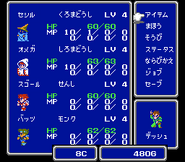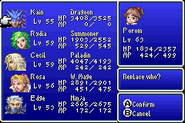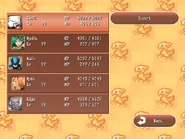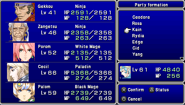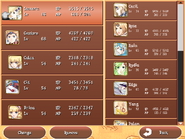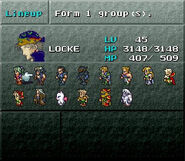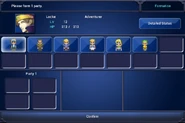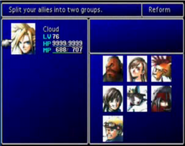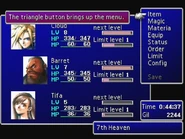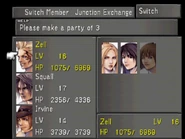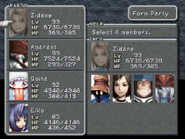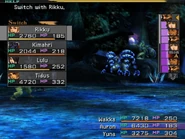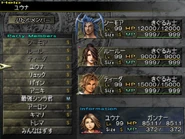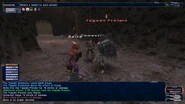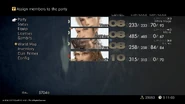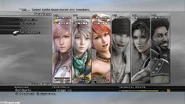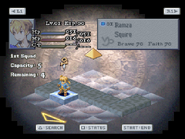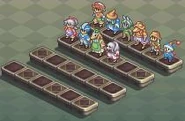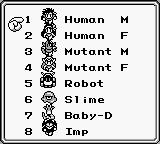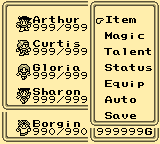
The party formation screen in Final Fantasy.
The term Party (パーティー, Pātī?) refers to the collection of characters under the player's control in the Final Fantasy series. Parties thus decide who the player takes into battle, making it a pivotal detail of the game's battle system.
Some games have set parties, with members joining and leaving as the plot demands it, such as Final Fantasy IV, while other games allow the player to swap party members in and out to form whatever team they desire, which began in Final Fantasy VI. The number of party members changes from game to game, but four is the most common configuration.
Most games also have a "party leader", usually the main protagonist, who must be present in the party at all times except under certain conditions. This party leader is usually the character that appears on the world map and locations, unless they are KO'd, when another character takes their place. Usually, after reviving, the leader retakes their place.
Appearances
Final Fantasy
Template:Sideicon The player chooses jobs for four party members at the start of the game, and the party and the jobs remains set for the entire game. The character that appears outside of battle is whoever is at the top of the formation.
Final Fantasy II
Template:Sideicon Firion, Maria and Guy are all permanently controllable in the party, with various other party members joining and leaving at set intervals. The party limit is four. The Middle character target bug is a bug in the NES version, where the middle two characters of a party battle formation tend to be attacked far more often than the top or bottom slot characters, and if one character were to be put in the back row out of those two characters, the character in the front row would take as many hits as the other character combined.
Final Fantasy III
Template:Sideicon As in Final Fantasy, the player controls four set characters, but allies join the party at set intervals. In the DS remake, allies serve as a "fifth party member" that can help out in battle; however, they take their turn before either side attacks, and cannot be damaged.
Final Fantasy IV
Template:Sideicon The party is made up of five characters, with two in one row and three in the other. As later games dropped back down to four or even three members, Final Fantasy IV boasted the largest party in the main series until the release of Final Fantasy XI 11 years later, and remains the largest party among single-player games. The game's protagonist Cecil Harvey is the only permanently playable character, and all other party members join and leave the party during the course of the game.
In the Advance release, after destroying the Giant of Babil, all previously playable party members except for Fusoya and Tellah can be swapped in and out of the party at will, but Cecil must always be present. This feature was removed for the Nintendo DS but reinstated in The Complete Collection release.
By default, Cecil is the party leader, but the player can switch it by pressing the L and R buttons in the SNES and Advance releases, the L1 and R1 buttons in the PlayStation release, the Y button in the Nintendo DS release, or the L and R in the PlayStation Portable release. This can only be done outside of battle and has no effect inside of one as it only determines which character shows up on screen when exploring.
Final Fantasy IV -Interlude-
Template:Sideicon The party is made up with the same amount as it was in the previous game, and functions the same way.
Final Fantasy IV: The After Years
Template:Sideicon As with its predecessor, there is a five-party limit. In addition, it has 22 permanent playable characters and 11 temporary characters, making the grand total of 33 playable characters. For most of the chapters, the party is automatically determined, with characters joining and leaving during plot points; however, during the last part of the Final Tale, the player is free to create a party from any of the main playable characters (though Cecil and Golbez must be in the party for the battle with the Dark Knight or the result is an instant game over).
Final Fantasy V
Template:Sideicon The playable cast is again limited to four, and the cast is set, although partway through the game, Galuf is replaced by his granddaughter Krile who receives all his skills. In addition, Lenna, and to a lesser extent Faris, are absent from the party for a short amount of time. This makes Bartz the only member to be in the team constantly, although there is a moment where only Galuf is controllable.
Final Fantasy VI
Template:Sideicon The party limit remains at four, and this was the first game in the series to allow players to change party members at will—for this purpose, eleven playable characters (the most of any Final Fantasy main series game), three hidden characters, and seventeen temporary characters were utilized.
Once the player gains access to these places, party members can be swapped around freely at Narshe, and later the player's airship, although on a few occasions, some characters will leave and cannot be chosen. At other times, the party is set for certain in-game events—for example, Locke and Celes must be in the party during the attack on Vector, but the other two party members can be whomever the player chooses.
In the World of Ruin, the party is scattered, and while the player is again free to make their own party they are limited to the party members they have found and/or rescued. Restrictions on who can be in the party only occur for subquests—for example, the subquest to hunt the monster Hidon can only be accessed once the player enters Thamasa with Strago and Relm in the party. Otherwise, Hidon will not appear. Notably, Celes, Edgar, and Setzer are the only characters the player is forced to recruit before the final dungeon becomes accessible, and it is possible to complete the game without recruiting any other characters. Doing this is a popular self-imposed challenge known as a C.E.S. game (for Celes Edgar Setzer).
In case of the empty party glitch the player ends up with no members in their party, freezing the game. It usually occurs through use of a GameShark.
When the player bets the Ichigeki at the Dragon's Neck Coliseum in the World of Ruin, they will fight Shadow. If the player chooses Gogo to go against him, if Shadow is the first one to attack, and if Gogo chooses the Mimic command, Gogo will mimic Shadow's last attack and attack him/herself. This happens because Shadow is classed by the game as a party member, despite appearing as an "enemy" for this battle.
Final Fantasy VII
Template:Sideicon The party limit is reduced to three, although the Materia system arguably makes up for the loss of an extra comrade with an added degree of customization to the party members. Fairly early in the game after leaving Midgar, the PHS lets the player change their party at will at Save points and on the world map.
At certain times the player will not have the opportunity to use the PHS, effectively making the party set for that time, and on other occasions certain party members must be in the party. Sephiroth is also available as a temporary party member in a flashback, but is AI-controlled. Cloud must be in the party at all times, except for instances where the party is split up (in which case Aeris and Barret lead, respectively), and a short period on Disc 2 when he leaves the party. Tifa and later Cid take his place as party leader during his absence.
Like in previous games, only the party leader (Cloud as default) is seen on the field, and the other characters disappear "inside" him when they join his party.
A parody of this scene was in the planning stages for the game, as revealed in Final Fantasy VII Ultimania Omega[1]:
Toriyama was always making weird, tricky little events like that that kept getting edited. For instance, there was once a scene on the station platform where Biggs, Wedge, and Jessie from AVALANCHE would face each other and try to combine into one. (...) When an event begins in Final Fantasy VII, the other two party members separate themselves from Cloud's avatar. Once the event finishes, the party recombines and Cloud is alone once more. It's just the way the game's set up, but Toriyama parodied that. The three members of AVALANCHE were like "Let's do that too!" and do their best to combine together, but they just ended up running into each other and muttering "I guess we still don't have enough practice." *laughing*
The party leader who cannot be switched out is labelled "Character #0" in the game code, while the two others are "Character #1" and "Character #2". Whenever the player leaves the main menu the game will check from top to bottom if a character has a set position. This is why entering the menu and using "Order" to re-arrange characters or switching the optional characters in the PHS menu will not affect which member is Character #1 or #2. To change this, a member must leave the party entirely and a new party member must be introduced.
Only if the player switches both of the optional characters and is led to the main menu can they affect which character becomes #1 or #2 by using "Order"; the game does the check first after leaving the main menu, so with no new spots settled the player can choose which optional member becomes #1 by placing them at the top (or if the party leader is at the top, place the optional member beneath the party leader).
The game calls for Character #1 or Character #2 to speak on the field and the player can adjust the party members to change which dialogue they are assigned to use. If Barret is in the party, he will speak, if not it will be Tifa, then Aeris and so on. The order in which team members' lines are prioritized varies, but in general the early members receive higher spots than later recruits. This means that when a priority ladder becomes long enough, the character at the last spot never gets to speak. This can lead to situations where the player normally never witnesses some dialogue in the game, because the characters the lines belong to are always at the bottom of the priority ladder.
There exists a glitch concerning the event where Yuffie Kisaragi is recruited, where the player can access PHS when not intended to be possible.
Final Fantasy VIII
Template:Sideicon The party limit is again limited to three, although the player can change the party at any time on the world map. Again, at certain times the party is set and certain members cannot be changed. Edea and Seifer are temporarily playable, and Laguna, Kiros and Ward make up their own party in certain sequences, but cannot be changed among the normal party members. Squall must be in the party at all times, except for a few occasions where the player controls two parties, in which case the second party is assigned an alternative leader.
Unlike other games, the party in Final Fantasy VIII does not disappear into the lead member. Instead, the other party members follow the leader's path exactly as he or she moves. This was likely done as an attempt to create a more realistic experience for the player. The exception to this is whenever the party appears on the world map, at which point only the party leader is visible.
Final Fantasy IX
Template:Sideicon The party limit is once again increased to four for Final Fantasy IX. For roughly the first half of the game, the party is set and cannot be changed except when given the option to do so as the plot requires. After acquiring the Blue Narciss, the party members can be changed as the player wishes.
Zidane is the party leader and must be present at all times, except for within Memoria and the Crystal World, where Zidane can be switched out (though he will still appear as the controllable character while not in battle).
Final Fantasy IX takes an alternate approach to scenes involving party members. Rather than disappearing and reappearing from the leader, cut scenes are utilized to initiate party interactions with each other, enemies and the environment. When the scene ends the screen will fade out and return with only the party leader present and ready to be controlled by the player.
Final Fantasy X
Template:Sideicon Unlike earlier games, players are able to switch between all seven characters mid-battle, though only three can be used at a time. If a party member is KO'd they cannot be replaced, and must be revived first. If all three current characters are killed or petrified (either turned to stone or shattered), the player gets a Game Over.
Tidus is the main playable character shown on the maps, with the exception of the Via Purifico scene, where Yuna briefly takes this position.
Final Fantasy X-2
Template:Sideicon
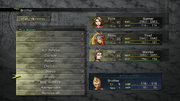
Party menu in Final Fantasy X-2 HD Remaster.
Yuna, Rikku, and Paine form the playable party throughout the entire game. However, there are two instances where this party is briefly split up.
Yuna is the main playable character shown on the maps, with the exception of the beginning scene in Luca, where Rikku briefly takes this position.
Final Fantasy X and X-2 use scenes involving party interactions similar to Final Fantasy IX, where cutscenes will involve all present characters and then disappear once the scene is over. Occasionally during gameplay party members will show up, usually acting as a guide for the player to follow and also to provide additional (mostly optional) dialogue.
In the International and HD Remaster versions the player can get AI-controlled party members, and choose them from a menu reminiscent to older Final Fantasy games.
Final Fantasy X-2: Last Mission
Template:Sideicon
Final Fantasy XI
Template:Sideicon A party refers to any number of characters between two and six members, one of whom is the leader, and giving Final Fantasy XI the largest parties in the main series since Final Fantasy IV. This organization is typically temporary, but players occasionally form bonds of friendship and create static parties. There is no official in-game term for this, it is a player-coined definition for people who commonly party together.
Parties form in the game to do various quests, missions, or to experience when multiple members would fare better collectively or have more fun than they would trying to do any one of those things by themselves. Parties appear on the screen in the lower right hand corner of the screen. The player's name who is viewing the list will always appear on top and the party members appear in the order they joined. The list includes names and the HP and MP of all members. The leader of the party always has a yellow dot before his name.
An Alliance is a group of two or three parties that band together to do even larger, more difficult quests. It is possible to form an alliance to try to get Experience Points, but in general this does not happen because of how experience is calculated. There are encounters that are too difficult for just one party. Often these include high level Notorious Monsters, certain Burning Circle fights, and quests that a high number of people want to complete together.
As far as how they are displayed, the additional two parties are displayed starting in the upper right hand corner of the screen. If there are two, the second party will be placed under the first. The alliance leader is given an additional white dot next to his yellow dot for being a party leader.
Since the game is centered on parties, there are certain (positive) spells that can only affect other party members. These spells or abilities include; Bard Songs, Regen spells, Refresh spells, Sneak, Invisible, or Deodorize.
The one exception to this rule is Ballista, a form of Conflict, where those spells can affect anyone on the same team. Spells that do not work for players outside of their own party do not work on players who are in other parties within alliances.
Final Fantasy XII
Template:Sideicon
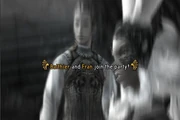
Balthier and Fran join the party.
Out of a main party of six characters only three can be used at a time, except for when a guest is in the party. Like in Final Fantasy X, party can be switched in and out, though this time KO'd party members can be replaced with non KO'd ones. Party members cannot be switched out if they are being targeted by an attack or ability of any kind (their name will appear red in the menu).
Characters not currently being used can be revived or healed by the party members who are in battle. If the active party is KO'd, or otherwise unable to fight, the player will be asked to bring at least one character from reserve into the active party.
The player only gets a Game Over once all six characters have been defeated. Vaan is the only party member that appears in towns, and he will appear even if he is KO'd. Outside, any character can be made party leader. The party leader is chosen by the player, though other than the camera following them they are no different from the other characters on the field, apart from the fact that if Fran is party leader NPC viera will speak different dialogue to the player.
Final Fantasy XII includes several allies and guest characters that are controlled by the computer. The allies appear in certain areas or even in some Hunts, fighting alongside the party for only a brief moment and have no relation to the party or the plot. Guests are like allies, but with some differences; guests actually enter the party and appear as a fourth member of the active party, but can't be switched with other party members.
Guests are also important to the plot and are often connected to the party. Guests, as they are party members, can be revived, however once allies die, they remain so. Neither allies, nor guests, can have equipment or gambits changed, nor can they level up.
In the Zodiac Job System version, the player can set the guest characters' gambits and control them, but still can't change their equipment.
Final Fantasy XII: Revenant Wings
Template:Sideicon The party is by default, forces the player to select five "leader" characters, but in addition, the player can summon plenty of Espers to join the leaders' parties. In certain missions however, the party may not always consist of five total party leaders. Every "leader" character has his or her own party, which consists of the leader and his/her summons. A party leader can have a maximum of eight Espers assigned to them.
The player can assign various buffs via equipment and abilities that usually only affect the leader's party and not other characters. In some battles, however, Espers cannot be summoned. Revenant Wings has nine playable characters and one temporarily playable character. All controllable units have blue health bar.
Like in Final Fantasy XII, in some areas of a mission, there are Guest or "Ally" characters. Guest characters may move about the area chasing enemies, or simply following the party leader nearest to them. Guests units' health bar are colored yellow instead.
Final Fantasy XIII
Template:Sideicon

Icon.
For the first half of the game, the story switches between the six main characters in parties of up to three, interconnecting at various points. The party leader is chosen by the game, and is the only character controlled in battle.
Only the roles of the other party members can be changed via the Paradigm system (Optima in the Japanese release), while the actual abilities they perform are automatically chosen by the game. If the party leader dies, it's Game Over, regardless of whether or not the other party members are still alive.
Once all six characters are obtained, the player is free to choose their own party of three and set their own party leader, but only outside of battle. The leader is represented by a small yellow flag.
Final Fantasy XIII-2
Template:Sideicon Serah Farron and Noel Kreiss fight alongside Paradigm Pack monsters during their travels. Serah and Noel are permitted to travel with three monsters at the same time with one of them fighting with each of the monsters having its own Paradigm role. There are moments during the game where Serah and Noel are separated, where they have to fight alone supported by a monster ally.
Lightning is also controlled in the game's opening and is playable in a downloadable content scenario, "Lightning's Story: Requiem of the Goddess". Additionally, Sazh Katzroy is controlled in his own downloaded episode, "Heads or Tails?".
Lightning Returns: Final Fantasy XIII
Template:Sideicon
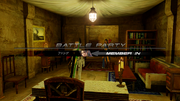
Fang joins Lightning's party.
Lightning is the sole playable character for much of the game, but she can be aided by guests who join her party. Party members are AI-controlled.
Final Fantasy XIV
Template:Sideicon
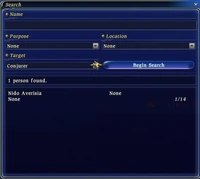
A party search in Legacy.
A party in refers to any number of characters between two and eight members, one of whom is the leader. Parties with two to seven members are known as light parties, while parties with all eight members are called full parties. With parties reaching a maximum of eight, Final Fantasy XIV supplants Final Fantasy XI as the main series game with the largest parties. While in a party, all members gain extra HP and MP, and a full party also grants accuracy bonuses to its members.
Similarly to Final Fantasy XI, this organization is typically temporary, but players occasionally form bonds of friendship and create static parties. There is no official in-game term for this, it is a player-coined definition for people who commonly party together.
Most content outside of regular Level grinding is balanced with parties in mind, such as duties and FATEs; accessing duties using the Duty Finder forces players into parties of specific sizes. Dungeons and guildhests typically use four player parties and trials use eight player parties, though there are exceptions to both rules. Raids use parties of eight, while some also enable alliances of three parties similar to Final Fantasy XI, for up to 24 players.
Parties appear on the screen in the lower right hand corner of the screen. The player's name who is viewing the list will always appear on top and the party members appear in the order they joined. The list includes names and the HP and MP of all members. The leader of the party always has a yellow dot before his name. It is possible to target other party members by clicking on his name, and players with enough TP to use a Weapon Skill have their names colored blue.
Final Fantasy XV
Template:Sideicon
Final Fantasy Tactics
Template:Sideicon Unlike main series games, players are able to create parties of whatever size that they wish, though only five characters can be used in battle at one time. Since characters can die permanently and new ones can be recruited, the party can be made up of very different characters from those that have places in the main storyline. Enemy generics and monsters can also be recruited into the party.
The player chooses the five characters from their party roster, and places them in the formation they start the battle in. These five can be any characters the player wants, except for main storyline battles, where Ramza Beoulve always must take part. Ally characters, whom the player does not control, also appear in storyline battles with set locations in the starting formation that the player does not control.
Final Fantasy Mystic Quest
Template:Sideicon The party is made up of two characters, the second slot is reserved for the temporary playable characters. The game's protagonist Benjamin is the only permanently playable character, and various allies join and leave him at certain points in the story.
The Final Fantasy Legend
Template:Sideicon There are many different races of characters for the player to choose from when they are creating their party. The different races in the game are Human, Mutant, and Monster. Furthermore, they may also choose either a Male or Female member from the Human or Mutant race.
Once a character has been introduced into the party, he or she cannot be removed unless he or she is dead. A party leader cannot be removed under any circumstances. The party leader is the character that is located in the first slot of the party. A character labeled as Dead may be restored at a House of Life if s/he still has a least one Heart. Characters with no Heart must be retired. The game's manual gives the player some recommendations.
Recommended groups:
- 4 Humans
- 2 Humans and 2 Mutants
- 2 Humans, 1 Mutant, and 1 Monster
Unrecommended groups:
- 4 Mutants
- 4 Monsters
Final Fantasy Legend II
Template:Sideicon The player chooses four out of eight possible characters types, and the fifth slot is reserve for guest characters. The game's manual that comes with the game gives the player some recommendations.
Recommended groups:
- 1 Human, 1 Mutant, 1 Monster and a Robot: A good group for beginners.
- 2 Humans and 2 Mutants: A very well balanced group.
- 2 Mutants and 2 Robots: This is a very good group and it should only be used by fairly experienced players.
Unrecommended groups:
- 4 Monsters: This group has many problems. They are unable to equip any of the powerful weapons and armor that can be found later in the game. The only good thing about this group is that they really have no use for money except for going to the Inn.
- 4 Robots: This group will need lots of money to supply them. The advantage to this group is that by they can never really run out of important weapons because the Inn will always restore them. However, the Robots will be unable to use spells and deal a high amount of damage.
Final Fantasy Legend III
Template:Sideicon Arthur, Curtis, Gloria, and Sharon are all permanently controllable characters in the party, with various other allies joining and leaving the party at set intervals during the game. The party limit is five characters, and the fifth slot is reserve for the guest character who are controllable during battle.
Final Fantasy: The 4 Heroes of Light
Template:Sideicon The player's party is fixed and the party members come and go as dictated by the plot. The maximum party is four characters. The player may assign the party leader who appears as the character to be controlled on the map, but the icon in the world map view is always Brandt. The game also features temporary party members.
Bravely Default
Template:Sideicon The player's party is fixed and consists of four members. Players can choose the party leader, who appears on the world amp and is cities or town. All four characters are directly controlled during battle.
Dissidia 012 Final Fantasy
Template:Sideicon Parties are made up of five members, and may either be predetermined according to the storyline the player is playing, or the player may be able to form their own party. The same rules go for Assists. When confronting Battle Pieces, the first party member in line fights, and if they are defeated the next party member battles the opponent in their place.
Party Battle Pieces and Mirror Pieces consist of enemy parties and must be fought by one of two rulesets. The "Round-robin" rules have the lead party members fight, then the second members, and so forth down the roster. The player must defeat enough enemies to claim a majority win (for example, three victories against a party of five) in order to defeat the enemy party. In "Tournament" rules, the lead party members fight, and when one is defeated the next character in line takes their place to fight their opponent. This continues until either party runs out of members.
Final Fantasy Type-0
Template:Sideicon A party consists of three characters, with the rest waiting as reserve members. For missions, the battle party is selected during preparation. It cannot be changed unless the player accesses a relic terminal during the mission, or if a party member is killed and not revived, allowing a reserve member to enter the party. On the world map, the battle party consists of the current field character and the two characters at the top of the reserve list. During battle, the player only controls the field character and can switch freely between any of the three party members. Party members not under the control of the player receive half damage and use half the amount of MP or Ability Gauge when executing actions.
All fourteen members of Class Zero are available for a majority of the main story, but there are a few points where certain party members are not available. Regardless of these absences, all characters can still be selected when replaying missions from the Mission List.
In the Final Fantasy Type-0 HD version the player can also choose to accept support personnel during missions, when AI-controlled "shadow" characters enter the party at random. This feature replaces the multiplayer feature from the original PlayStation Portable version. When the support personnel enter the party, the other party members are relegated to the reserves.
Final Fantasy Airborne Brigade
Template:Sideicon The player has the option to search for other players in the game and invite them to a party they have formed. If they accept their invitation, they will all receive potions in the player's login bonuses and the number of potions they can use per day will increase. The maximum number of people in a party is ten. Becoming a party member will assure that the player and other members are always assigned to the same brigade. They must send out a request and wait for acceptance into another player's party and they must approve those that ask to join theirs. To ask to join a Party, the player must tap on "Search for members" in the main menu or tap on the "Event" button at the bottom of the screen.
Final Fantasy All the Bravest
Template:Sideicon The max slots for party members is 40, this means that forty party members will participate in battle. The player initially has up to 32 slots for party members, the remaining 8 must be unlock through the SNS menu option. This option will post an advertisement for the game on the player's social networking website such as Facebook or Twitter. The player will be rewarded every 24 hours with an unlocked party slot, but only up to 8 slots.
Gallery
References
Template:Recurring Elements

